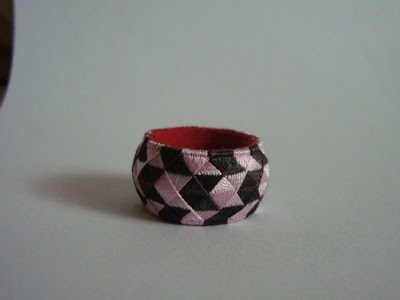****** updated ******
I feel the need to tell you the definition of scales design. The scales design is made when each stitching path is done alternatively and each path in solid colour. Either the number of sections or colours used doesn't matter. As long as all the paths were stitched alternatively, it's a scale design. I am not very sure if "arrow's shaft feather" should be included, especially a path makes rounds, but I decided to include it, too, at least this time.
Thank you. Chloe Patricia
****** update ******
Since suggested, I have been toying with the idea of Monthly Challenge. When I firstly started the photo sharing at Flickr, my intention was to start from the simple bi-colour scales and to proceed to the more complexed designs. However, I soon realized that it wouldn't work like that. My photo sharing is not a monthly subscription programme which allow anyone start any time from the very beginning therefore choosing one particular design may exclude some people from joining the group and it's not my intention at all. My group has to be something everyone can join.
After considering the options, I have decided to have our first challenge this month, the challenge being scales designs. This may not be what you have expected. I understand that challenge is something worth challenging and scales is just scales, the most basic design. One of the reasons I chose the design is my lack of preparation time however, the main reason is I feel scales design is underappreciated and you might enjoy re-discovering the possibility of the design and of course scales design can allow the new people join the group with their very first bi-coloured scales, too.
For the people with advanced skills, I would like to suggest to try the narrower sections. The above picture shows you my contribution this month and it's 32 sectioned thimble with period of 8 sections in three colours. I can tell you it's a challenge to have a marking paper sectioned into 32 and stitching with eight thread simultaneously.
To make the challenge worthy to be called a challenge, I would like to restrict the size and shape to a thimble and thimble only this month.
Here are the rules:
1. The thimbles have to be your own work.
2. For the sake of the challenge this month, the rings you make have to be thimbles. That means the size of the mould should be about 5-6 cm in circumference.
3. As stated above, they have to be your own works however, you can use the thimble base from the kit if you choose to do so. It may not seem to be fair, considering I sell the kits, however, they are many other kits available (at least in Japan) and some of you may be able to obtain them, and it is definitely not fair to exclude the people who is brave enough to share their first work with us from the group.
4. The design has to be scales. The number of the period of sections is up to you from bi-coloured scales (period of two) to whatever you would like.
5. You can use any material, and in any colours, you would like. Please note that you do not restrict yourself to use four colours for period of four design. Two colours or three colours, or even single colour will work just fine. Mine in the picture is period of eight sections with only three colours. Please experiment on the colours, you would be surprised to discover the possibilities there.
6. Please state the size of the mould on which you formed your thimble base in the description field of the photo, either in millimeters or in inches. Please also mention what threads and padding you used, too, so that we could compare notes. In case you bought my kit, it is 50mm in circumference and Tire Silk size 9 and floss silk padding.
7. You can upload as many photos as you like. You can upload several photos of one thimble if you choose to do so.
8. The closing date is 21st of April 2011, Japan time. Please note that we are 9 hours ahead of GMT (Greenwich Mean Time) in Japan. You can still upload your photo after the official closing date and share it with use since I do not close the photo sharing pool.
Now you can start uploading your photos from here at
Flickr.
I am sorry but no lucky draw this month. Not that I do not want to give my contribution of the month away. Although the photo sharing has been successful, we seldom have a new member and I am not very comfortable to keep a draw in such a small group as most, if not all, of the participants have already won at least once. Until we have a large number of the participants I will withhold the draw. However, the discussion board is open at Flickr for this month's sharing. Please feel free to leave your comments there once your thimbles are up.
Will you please invite your friend to join the group. Thimble making is not particularly difficult when compared to other needle crafts and it does not need much material to make while it's fun. For those of you who have not made one yet and wish to start a new hobby (mind you, thimble making is addictive), I have sort of tutorials under the tag of "how I do" and for those of you who are wondering what "period", I will publish a post and explain it within a few days, so please be patient with me.













